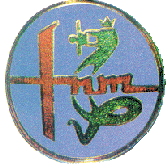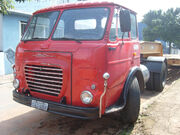 FNM logo, largely inspired by the Alfa Romeo logo | |
| Founded | 1942 |
|---|---|
| Defunct | 1988 |
| Headquarters | Duque de Caxias, Rio de Janeiro, Brazil |
| Products | automobiles, trucks, buses |
Fábrica Nacional de Motores (FNM) was a Brazilian manufacturer of trucks, engines and motor vehicles based in the Xerém district of Duque de Caxias near Rio de Janeiro that operated between 1942 and 1988.
Origins[]
The company was created 1942 by the Brazilian state as part of the Estado Novo agenda of President Getúlio Dornelles Vargas. It was one of several business launched by the state during this period (including also Companhia Siderúrgica Nacional launched in 1941 and CHESF in the later 1940s) to kick start an industrial sector in Brazil. Initially the company produced American Curtiss-Wright aircraft engines under license along with ammunition, bicycles, spindles and refrigerators.[1] A tractor prototype was created in the 1940s, the FNM MSTM.
After the Second World War it was decided to diversify production. The government was keen to launch a vehicle manufacturing industry. In 1949 an agreement was reached with the Italian manufacturer, Isotta Fraschini, whereby FNM would produce the Milanese company's heavy trucks under license. Isotta Fraschini commercial vehicles enjoyed an excellent reputation at this time, but the Italian company was already economically troubled, although its formal bankruptcy would be put off till the end of 1951.
For at least a few years during the mid-1950s, FNM manufactured Fiat-based tractors using some local content.
The Alfa Romeo connection[]

The FNM 210 clearly shows its Alfa Romeo origins in design.[2]
The disappearance of Isotta Fraschini as a vehicle manufacturer left FNM looking for a new technology partner. In 1952 an agreement was signed with Alfa Romeo, another Milanese vehicle manufacturer. Unusually in Europe, Alfa Romeo was (like FNM) a state owned business, following bankruptcy and a government rescue in the 1930s. Under the agreement with Alfa Romeo, FNM would manufacture Alfa Romeo's commercial vehicle range under license. Though little known north of the Alps, Alfa Romeo commercial vehicles were well established in Italy, and other south European markets. Between 1956 and 1960 FNM built more than 15,000 heavy trucks of Alfa Romeo design: it also manufactured the chassis for buses and coaches. In the Brazilian heavy truck sector which FNM dominated till the early 1970s, FNM was initially the only manufacturer. Trucks produced by FNM were generally called as Fenemê.[3]
In 1960 the range was extended to include passenger cars, with the launch of the FNM 2000, a Brazilian version of the Alfa Romeo 2000 four door sedan (berlina). The engine was the same 1975 cc twin camshaft unit found in the Italian product, but detuned to produce only 9|hp. A coupé version was offered from 1966. Known as the FNM Onça, the coupe did not follow the line of any Alfa Romeo design, but featured an elegant locally designed body unmistakably reminiscent of the original Ford Mustang. The FNM 2000 was followed by more powerful versions, culminating with the 130hp TiMB ("Turismo Internazionale Modello Brasile"), now boasting usefully more power than was claimed for its Alfa Romeo cousins of the time.
Alfa Romeo control[]
In 1968 Alfa Romeo acquired a controlling share in the FNM business: the next year the FNM 2000 was replaced by a restyled version, the FNM 2150, the most obvious visual differences affecting the front of the car. For this application the twin camshaft four cylinder engine saw its capacity increased to 2132 cc, and performance was further enhanced by the installation of a five speed gear box in place of the (at that time still more usual with Italian style passenger cars) four speed one of the 2000. The FNM 2150 would continue in production from 1969 till 1974.
In 1972 another coupé the Furia GT 2150 was presented to the public. Based on chassis and mechanics of the FNM/JK 2150 cc model, the car was designed by Brazilian designer Tony Bianco.[4][5] Only a few hand built examples were produced, but the stylish coupé may have helped the public image of the by now aging design of the mainstream FNM 2150.
Alfa Romeo had disposed of its commercial vehicle operations in Italy in the 1960s, and in 1973 the FNM commercial vehicle business was sold to Fiat's, industrial vehicle division. The business would subsequently be absorbed into Fiat's Brazilian Iveco business. At this stage, however, Alfa Romeo retained responsibility for the FNM automobile business.
Closing chapter[]
1974 saw the FNM 2150 replaced with the Alfa Romeo 2300. This was the end for the FNM badged cars: the FNM badge itself, obviously inspired by the Alfa Romeo badge, was also replaced on this car with an actual Alfa Romeo badge. The general look of the new car was very similar to that of the Italian built Alfetta sedan, designed by Giuseppe Scarnati and first offered in Europe in 1972, although the Brazilian car was actually 41cm longer and 7cm} wider than the Alfetta. Under the skin, the 2300 was based technically on the older Alfa Romeo 1900.[6] The gear box of the 2300 was conventionally located adjacent to the engine and not (as with the Alfetta) across the rear axle. Like its Brazilian predecessor the 2300 featured a four cylinder twin camshaft engine, now of 2310 cc with a claimed output of 140 hp (100 kW). A maximum speed of 170 km/h (106 mph) was claimed. For the 1985 model year the 2300 was renamed as "Alfa Romeo 85".[6] This model was manufactured until November 1986.
Marketing opportunities were identified in Europe where Alfa Romeo's locally designed attempt to move upmarket had made little impact on the competition from Bavaria: the Brazilian Alfa Romeo was offered briefly in 1981 under the designation Alfa Rio and distributed by Alfa Romeo Germany,[7]. In addition around 600 of the cars were shipped to The Netherlands.
The end[]
Alfa Romeo faced difficulties in Europe during the late 1970s and early 1980s, coming under increasing commercial pressure from the three largest German up-market auto producers even in Italy. Objective financial data concerning nationalised businesses are seldom published, but Alfa Romeo is believed to have operated at a substantial loss for much of its time under state control: in 1986 Romano Prodi who was at the time chairman of the IRI (the government body responsible for nationalised industries in Italy), wishing to reduce the losses of the IRI, transferred Alfa Romeo to the private sector, which in Italy's m*** market automobile business meant at this time Fiat. Since 1976 Fiat had been developing its own Brazilian operation, based in Betim. The Brazilian based car business that had formerly comprised FNM was accordingly integrated into Fiat's own Brazilian operation, and in 1988 the FNM badged commercial vehicles - already produced by a Fiat owned business since Alfa Romeo sold the business in 1973 - were rebadged as Iveco products.
Automobile production volumes[]
Production volumes of the FNM 2000/2150, to the extent these can be determined:[8]:
- 1966: 474
- 1967: 714
- 1968:
- 1969: 555
- 1970: 1,209
- 1971: 800
- 1972: 600
References[]
- Automobil Revue, Katalognummern 1968 bis 1973 (technical data)
- auto katalog, 1985/86 edition (ti4 data)
- ↑ "alfa romeo's Brazilian connection 1950-1986". italiaspeed.com/2005. Retrieved on 2008-06-28.
- ↑ "Brazilian trucks from the 'Brochure King'.". roadtransport.com. Retrieved on 2009-06-04.
- ↑ "FNM". djjaragua.vilabol.uol.com.br. Retrieved on 2008-06-29. (Portuguese)
- ↑ "Toni Bianco". bandeiraquadriculada.com.br. Retrieved on 2008-06-28.
- ↑ "fnm - alfa romeo's Brazilian connection 1950-1986". italiaspeed.com. Retrieved on 2008-06-28.
- ↑ 6.0 6.1 "The Alfa Romeo Rio, or Alfa Romeo 2300.". xs4all.nl. Retrieved on 2008-06-28.
- ↑ auto motor und sport, Heft 3/81, S.37
- ↑ Automobil Revue, Katalognummern 1968-1973
External links[]
- FNM - Fabrica Nacional de Motores in Xerém, Rio de Janeiro:The beginning of aviation and automotive industry in Brasil
- FMTSP Museum (Portuguese)
- Documents and photos (Italian)
- Documents (Italian)
- Brazilian FNM 2300 website (Portuguese)
| This page uses some content from Wikipedia. The original article was at Fábrica Nacional de Motores. The list of authors can be seen in the page history. As with Tractor & Construction Plant Wiki, the text of Wikipedia is available under the Creative Commons by Attribution License and/or GNU Free Documentation License. Please check page history for when the original article was copied to Wikia |
| ||||||||||||||||||||||||||||||||||||||||||||||||||||||||||||||||||||||||||||||
| ||||||||||||||||||||||||||||||||||||||||||||
| |||||||||||||||||||||||||||||||||||||||||||||||||||||||||||||||||||||||||||||||||||||||||||||||||||||||||||||||||||||||||||||||||||